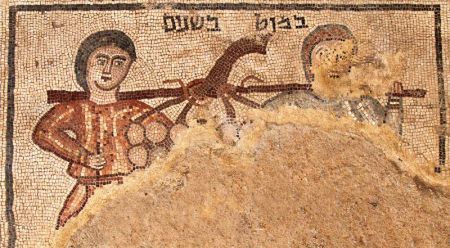Mosaic of Moses' Spies Who Explored Canaan Discovered in Israel

A team of specialists have discovered several mosaics in Israel, including one depicting two men carrying a pole with a cluster of grapes, believed to be the two spies Moses sent to scout the land of Canaan, as found in the book of Numbers in the Bible.
The University of North Carolina at Chapel Hill team announced on Monday that the first mosaics were discovered at the site of Huqoq in Israel's Galilee, where the synagogue excavations are taking place, in 2012 by a team led by University of North Carolina at Chapel Hill Professor Jodi Magness.
With the assistance of Shua Kisilevitz of the Israel Antiquities Authority and Tel Aviv University, they have uncovered additional mosaics every year, including that of Samson carrying the gate of Gaza, Noah's Ark, the parting of the Red Sea, Jonah being swallowed by fish, and the building of the Tower of Babel.
Identifying the significance of the mosaics, UNC-Chapel Hill said, "The discoveries indicate villagers flourished under early fifth century Christian rule, contradicting a widespread view that Jewish settlement in the region declined during that period."
Magness, who is president of the Archaeological Institute of America and has participated on 20 different excavations in Israel and Greece, commented, "The mosaics decorating the floor of the Huqoq synagogue revolutionize our understanding of Judaism in this period."
"Ancient Jewish art is often thought to be aniconic, or lacking images. But these mosaics, colorful and filled with figured scenes, attest to a rich visual culture as well as to the dynamism and diversity of Judaism in the Late Roman and Byzantine periods."
The latest mosaic to be identified depicts two men with Hebrew inscriptions, with one of the panels, labeled "a pole between two," most likely referring to Numbers 13:23.
The passage refers to two spies sent by Moses to investigate the land of Canaan following the Exodus from Egypt, who "cut off a branch bearing a single cluster of grapes" in the Valley of Eshkol.
Later on in the biblical account, the spies return to Moses and report, "We went into the land to which you sent us, and indeed, it is flowing with milk and honey." (Numbers 13:27)
Another panel that was uncovered referenced Isaiah 11:6 in the inscription, "a small child shall lead them," with the depiction featuring a youth leading an animal on a rope.
Also, in "a rare discovery in ancient synagogues," the team uncovered "columns covered in colorful, painted plaster still intact after nearly 1,600 years."
"The mosaics have been removed from the site for conservation and the excavated areas have been backfilled. Excavations are scheduled to continue in the summer of 2019."
National Geographic Society, which has been supporting the Huqoq excavations, says that the mosaics also include a non-biblical scene — the legendary meeting between Alexander the Great and the Jewish high priest.
"This just enriches what we know about Judaism in late antiquity — how vibrant and dynamic and diverse it is," Magness said.
Other significant discoveries from the time of Moses include the March 2016 finding of a 4,200-year-old necropolis at the site of Khalet al-Jam'a, located near Bethlehem, and dating back 2200 BCE to 650 BCE.
The tombs, many of which had been destroyed by looters, are believed to have served as the burial place for multiple family generations, which follows Deuteronomy 31:16 and the description that Moses will "rest with [his] ancestors."





















